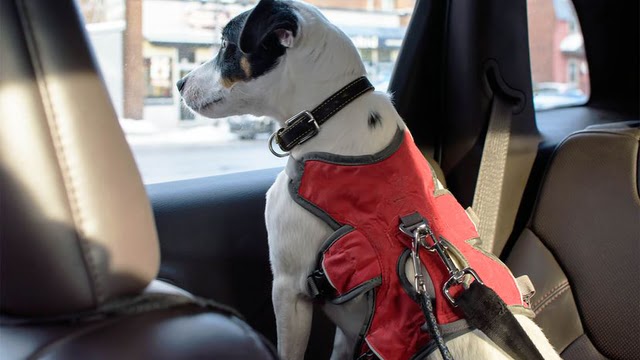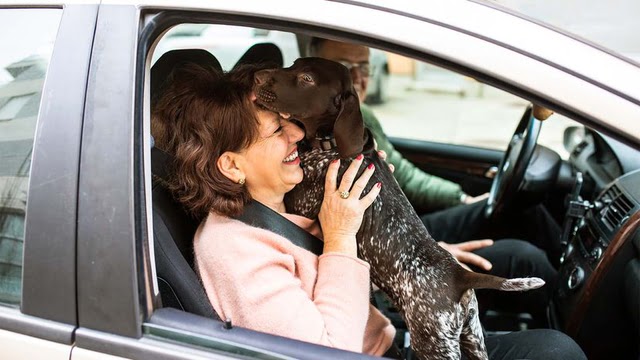Quck answer
Dogs should wear seat belts while traveling in cars for their own safety. In case of an accident, an unrestrained dog can become a dangerous projectile and cause harm to themselves and others in the car. Additionally, an unsecured dog can distract the driver, increasing the risk of an accident. Seat belts designed for dogs are widely available and can be easily attached to a car’s existing seat belt system. It is important to choose the right size and type of seat belt to ensure maximum safety for your furry friend.
Pets

It is important for dogs to wear seat belts while traveling in a car. This is not only for their own safety, but also for the safety of their owners. A search on Google for “dogs lost after car accident” brings up numerous stories about dogs being lost after being ejected from cars during major accidents or running off in the chaos that follows. While some dogs are found quickly, others are lost forever or worse, dead. Therefore, it is essential to put your furry family members in a dog seat belt to keep them safe and secure while on the road.
Most Dogs Are Not Restrained in Cars
According to the National Pet Owners Survey, 40% of pet owners travel with their dogs. However, as shown by the stories of lost dogs, it can be dangerous if they are not restrained properly. In a study conducted by Volvo and The Harris Poll in 2019, one-third of respondents preferred to travel with their dog instead of their family, but two-thirds of them believed that their dog would be unsafe in the car in case of an accident. Despite this, many pet owners still allow their dogs to roam unrestrained. Dr. Georgina Ushi Phillips, a veterinarian and veterinary writer, says that it is a cultural norm for owners to let their dogs loose in the car. However, in case of a crash, dogs, people, and anything else in the car can become projectiles. Jordan Schaul, a Ph.D. in conservation and comparative medicine, experienced the danger of having an unrestrained dog when his rescue Doberman hit the dashboard of his car. Therefore, it is important to use a safety harness to keep dogs safe and secure while traveling in a car.

Allowing your dog or puppy to run around freely in the car can be very dangerous, especially when they climb up in the front seat near the driver. According to a study by Volvo, driving with an unrestrained dog is not just unsafe for the dog, but for everyone else in the car too. Hazardous driving behaviors double when dogs are unrestrained compared to when they are restrained. Dog seat belts are a safer way to travel with pets as they provide restraint and safety. A veterinarian at Branchville Animal Hospital in Odenville, Alabama explains that many dogs jump around in a car and may try to jump in the driver’s lap, which could lead to an accident. Furthermore, dogs need to be tethered to a safe point in the event of an accident to keep them from being ejected from a vehicle. Dog seat belts are also beneficial to pets and humans after accidents as they secure dogs who may interfere with first responders. Experts agree that dog seat belts are the best way to keep your pup safe in the car. However, there are so many different designs on the market, from zip line contraptions that give dogs room to roam to thick, padded harnesses that look like BabyBjГ¶rns. A harness is preferred over a collar as it contains multiple points of contact and won’t put too much stress on one body part like the neck. Dog seat belts aren’t perfect for every dog, and size and temperament need to be considered. Medium and smaller dogs are often better suited for dog car seats, whereas larger dogs are better suited for seat belts. Dogs or puppies that chew may do better in a carrier than a seat belt. One issue with choosing a dog restraint is that there are no formal standards for pet safety crash tests. The pet product industry can label products as “crash-tested” or “safety-approved” without having any actual data or proof to back it up.
Pet Safety Certified by Center for Pet Safety after Crash-Tests
The Center for Pet Safety (CPS), a non-profit organization for pet safety, conducted a series of crash-tests on pet harnesses, carriers, and crates between 2013 and 2015. The tests were funded by Subaru and no real dogs were used; instead, CPS utilized three different-sized dummy dogs, including a terrier mix of 25 pounds (11 kilograms), a border collie of 45 pounds (20 kilograms), and a golden retriever of 75 pounds (34 kilograms) for the harness tests. Only three harnesses were granted the final crash-test certification after rigorous testing modeled after the FMVSS 213 standard, which is the same standard used for child safety seats.

The Rocketeer Pack is one of the three pet safety harnesses that are certified after crash-tests by the Center for Pet Safety.
ZuGoPet
Phillips suggests harnesses, particularly those tested by reliable sources like CPS. “However, it does not mean that safety belts tested only by CPS are safe,” she clarifies. “Several other brands conduct their own third-party crash testing. Enough brands have carried out some type of crash testing that people should opt for a brand that has some real-world data to support it.”
Phillips states that the major problem with a harness or restraint is its size. Therefore, ensure that you get the right size. “Harnesses that are too big could be dangerous because they could encourage dogs to try to wriggle out,” she explains. “Harnesses and seatbelts that are too tight could cause chafing or skin irritation, particularly if dogs are continuously testing the limits of their restraint.”
Pet restraints are not only the safest way to travel with pets, but they are also required by law in some five U.S. states: Connecticut, Maine, Minnesota, New Hampshire, and Rhode Island. Washington D.C. has the “Distracted Driving Safety Act of 2004,” which includes interacting with pets. Violating any of these laws could result in fines or even jail time. It is worthwhile to spend some time reviewing the laws in your state.
If you’re ready to hit the open road with your furry sidekick, Phillips has some suggestions to get started. “Let dogs wear the harness while playing inside the house. The aim is to create positive associations with the harness. Patience, praise, and treats will help,” she says. “Once dogs are calm and relaxed in their harness, it’s time to hit the road!”
Now That’s Funny
Pet owners who love their pets are known to do some very ‘extra’ things for them. Perhaps none more fascinating than a chastity belt to prevent any “oops” puppies!
FAQ
1. Why do dogs need to wear seat belts?
Just like humans, dogs can get seriously injured or killed in a car accident if they are not properly restrained. In fact, an unrestrained dog can become a projectile during a collision, potentially injuring themselves and other passengers in the car. Additionally, an unrestrained dog can distract the driver and cause an accident. Wearing a seat belt or using a dog-specific car seat can help keep your furry friend safe and secure during car rides.
2. Is it necessary to buy a dog-specific seat belt or car seat?
While it is not necessary to buy a dog-specific seat belt or car seat, it is highly recommended. These products are specifically designed to fit dogs and provide them with the best possible protection in the event of a car accident. They are also often more comfortable for dogs, which can make car rides less stressful and more enjoyable for both you and your furry friend.
3. How do I choose the right seat belt or car seat for my dog?
When choosing a seat belt or car seat for your dog, it is important to consider their size and weight. Look for products that are specifically designed for your dog’s size and weight range. Additionally, make sure the product is crash-tested and meets safety standards. Read reviews and do your research to find the best product for your furry friend.
4. Can I still let my dog hang their head out the window if they are wearing a seat belt?
No, it is not safe for dogs to hang their head out the window, even if they are wearing a seat belt. Objects can hit them in the face, and they can also be injured if the car suddenly stops or swerves. It’s best to keep your dog’s head and body inside the car at all times.
5. Are there any other safety precautions I should take when traveling with my dog?
Yes, there are a few other safety precautions you can take when traveling with your dog. It’s important to never leave your dog alone in a parked car, as temperatures can quickly become dangerous. Additionally, make sure your dog has access to water and take frequent breaks to allow them to stretch their legs and use the bathroom.
6. Are there any laws regarding dogs wearing seat belts?
Currently, there are no federal laws requiring dogs to wear seat belts or be restrained during car rides. However, some states and cities have their own laws regarding pet travel safety. It’s important to check the laws in your area and follow them to keep your dog safe and avoid any potential legal trouble.
7. Can I train my dog to wear a seat belt?
Yes, you can train your dog to wear a seat belt or use a car seat. Start by getting your dog used to wearing a harness or collar, and then gradually introduce the seat belt or car seat. Be patient and positive, and reward your dog with treats and praise for good behavior. With time and practice, your dog will become comfortable and secure in their safety gear.





Leave a Reply